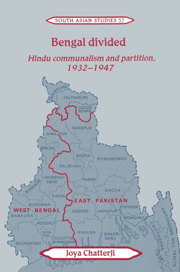Book contents
- Frontmatter
- Contents
- List of maps
- List of tables
- Acknowledgements
- List of abbreviations
- Glossary
- Map 1 Bengal districts
- Introduction
- 1 Bengal politics and the Communal Award
- 2 The emergence of the mofussil in Bengal politics
- 3 The reorientation of the Bengal Congress, 1937–45
- 4 The construction of bhadralok communal identity: culture and communalism in Bengal
- 5 Hindu unity and Muslim tyranny: aspects of Hindu bhadralok politics, 1936–47
- 6 The second partition of Bengal, 1945–47
- Conclusion
- Appendix
- Bibliography
- Index
- Cambridge South Asian Studies
3 - The reorientation of the Bengal Congress, 1937–45
Published online by Cambridge University Press: 04 August 2010
- Frontmatter
- Contents
- List of maps
- List of tables
- Acknowledgements
- List of abbreviations
- Glossary
- Map 1 Bengal districts
- Introduction
- 1 Bengal politics and the Communal Award
- 2 The emergence of the mofussil in Bengal politics
- 3 The reorientation of the Bengal Congress, 1937–45
- 4 The construction of bhadralok communal identity: culture and communalism in Bengal
- 5 Hindu unity and Muslim tyranny: aspects of Hindu bhadralok politics, 1936–47
- 6 The second partition of Bengal, 1945–47
- Conclusion
- Appendix
- Bibliography
- Index
- Cambridge South Asian Studies
Summary
Scholars are coming to recognise the era of ‘provincial autonomy’ as a period of heightened communal consciousness, during which organised politics increasingly fractured along lines of community. In the six Hindu-majority provinces where the Congress held office between 1937 and 1939, it has been argued that Congress policies raised, in Muslim eyes, the spectre of a ‘Hindu Raj’. In Bengal, where Hindus, a large and vocal minority, were at best junior partners in the exercise of provincial autonomy, developments took a different course. But here too social and political divisions hardened along communal lines. Between 1937 and 1945, four ministries took office in Bengal, each attempting to achieve a stable accommodation between the different political interests. But by 1945, when negotiations began in earnest for the ending of British rule, there was little evidence among Bengal's politicians of a spirit of compromise. These were years of great complexity, as parties and factions variously split, changed sides or regrouped. This chapter will not attempt to provide a detailed narrative of the political manoeuvrings of this period. Instead, it will focus on broad trends in the Bengal Congress so as to identify the shifts and alignments that pushed politics into the communal abyss.
The Congress and the ‘left’ initiative
On April Fool's Day 1937, Fazlul Huq was sworn in as the first premier of Bengal, at the head of a Krishak Praja–Muslim League coalition ministry.
- Type
- Chapter
- Information
- Bengal DividedHindu Communalism and Partition, 1932–1947, pp. 103 - 149Publisher: Cambridge University PressPrint publication year: 1994
- 1
- Cited by



